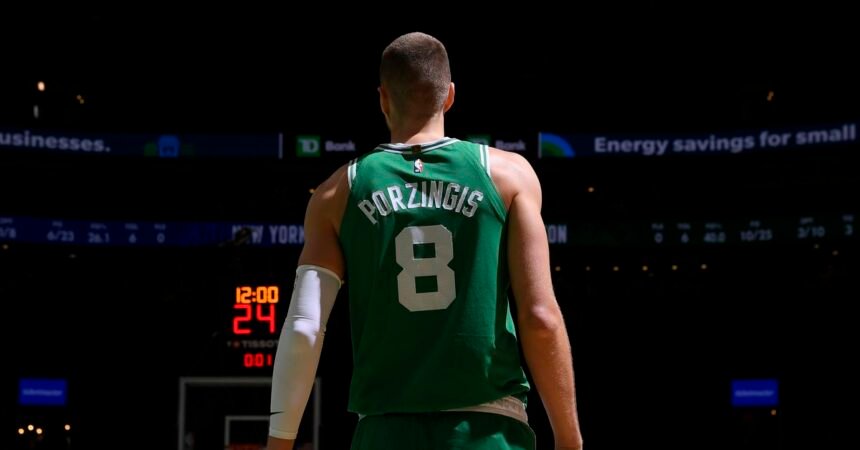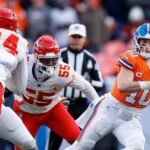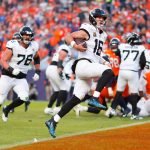Free agency has (largely) come and gone for the Hawks with the exception of some minor moves to make around the edges.
With all eyes focused on what the Hawks do with the flexibility of multiple large traded player exceptions (TPE), the mid-level exception (MLE), and a desire to put forth a more competitive team in a wide-open Eastern Conference, general manager Onsi Saleh and the Hawks front office delivered in a big way.
So, with that, I weigh in and grade based on what I thought about each of the major moves the Hawks made up to this point — both in reshaping their roster for the present and the future.
Trading Mann, Niang, 2025 first for Kristaps Porzingis
This one was the opening salvo in a series of domino-like moves. The move ultimately roped in both the Boston Celtics and the Brooklyn Nets, with the Celtics picking up Georges Niang and the Nets absorbing Terance Mann’s $47 million owed over the next three years in order to acquire the 22nd overall pick in the 2025 NBA Draft. That pick later became UNC wing Drake Powell.
Niang and Mann came to the Hawks at the trade deadline in deals involving De’Andre Hunter and Bogdan Bogdanovic respectively, but frankly neither exactly covered themselves in glory in the roughly 30 games in a Hawks jersey. While Niang spaced the floor well from the forward position (41% from three on 6.6 attempts per game), his lack of agility and defensive range just about erased any positives earned on the opposite side of the floor.
Terance Mann was the more problematic of the two, however. While he’s a serviceable bench wing who doesn’t hurt you defensively and also shot the ball well from deep (39% from three on 2.9 attempts per game with the Hawks), his passivity could, at times, bog down the offense. Additionally, his try-hard defense wasn’t quite as impactful as originally advertised — although, to be fair, he was unfairly deployed at the 4 far too often.
But really it was the $47 million owed to him over the next three years — via an extension signed with the Clippers — that was the reason for Atlanta having to attach a first rounder to get off his money. That $15.7 million annual value is roughly sixth man money for ninth or tenth-man contributions.
And so those two got folded into a transaction where the Hawks found themselves at the right place at the right time. With the Celtics looking to duck below the second apron in the wake of Jayson Tatum’s injury, Atlanta swooped in to land the expiring $30.7 million contract of Kristaps Porzingis.
Porzingis is a case of “you can’t teach 7’2” with post turnaround moves.” And his defensive range (career 2.9 blocks per 100 possessions) and shooting (career 37% three-point shooting) give the Hawks a unicorn with which Trae Young has never before been able to pair with on a pick-and-pop.
Even if ‘KP’ only gives the Hawks 25 minutes per game across 50 games this season due to injuries and ailments, the Hawks have a starting-caliber center in Onyeka Okongwu as insurance. It’s such a low risk move to move off Mann’s future money and only surrender a low first-round pick that this can’t be anything more than a big win.
Grade: A-
Swapping 13 for 23 and the best of Bucks/Pelicans 2026 first
This move certainly raised eyebrows around the league — and from Atlanta’s perspective only for the right reasons.
After executing the above trade for Porzingis the day before the first round of the draft, the Hawks came into the night with just the 13th overall pick via the Sacramento Kings. Once the Hawks were on the clock, in came a report that the New Orleans Pelicans — despite having nabbed Oklahoma’s Jeremiah Fears with the seventh overall pick — had moved into position at that slot.
No one could have imagined that the cost would be so steep for Pelicans president of basketball operations Joe Dumars to get his guy, Derik Queen from Maryland.
For the low, low cost of moving down just 10 spots in the draft, Atlanta picked up not just an unprotected first-round pick in what projects to be a strong 2026 NBA Draft. They picked up the most favorable of the Milwaukee Bucks and New Orleans Pelicans in what projects to be a strong 2026 NBA Draft. Again, this pick is unrestricted and regardless of the results of the lottery should it land there.
So, the Pelicans, who are coming off a 21-61 season with major availability questions surround their two main drivers on offense, Zion Williamson and Dejounte Murray, and the Milwaukee Bucks, who have built a completely uninspiring roster around Giannis Antetokuonmpo, could convey a massive windfall of a pick this time next year.
And, to top it off, the Hawks were able to purportedly get their guy they heavily considered at 13 down at 23. This is a flawless victory in my eyes.
Grade: A+
Drafting Asa Newell 23rd overall
Newell is a local boy (born in Atlanta and raised in Athens) who grew up a Hawks fan and spent his one-and-done season at the University of Georgia. On the court, he’s a swing big man who brings size, motor, elite rim finishing, and is just 19 years of age coming to a strong Hawks developmental program.
I have major questions about his shooting upside, his passing and short roll vision, his somewhat disappointing wingspan (6’11 1/4”) and standing reach measurements (8’11 1/2”) compared to his 6’9 barefoot height per the combine, but ultimately I really can’t knock the pick too much.
There were a couple of guys remaining on my draft board I personally had higher for the Hawks to land here, and I would be much more critical of this pick had the Hawks taken him at 13, but late in the first round it’s a decent flier. If nothing else, he should form a solid pick-and-roll partnership with Trae Young and contribute defensively, and he fits the hardworking ethos that Quin Snyder and his coaching staff have instilled during the current regime.
Grade: B-
Signing Nickeil Alexander-Walker for a reported $62 million
Nickeil Alexander-Walker was one of the most talked about unrestricted free agents in this class in the lead up to this summer. After being more of an on-ball guard between Virginia Tech and in his first three NBA seasons with the Pelicans after being drafted 17th overall in 2019, he had carved out a nice role coming off the bench for a resurgent Minnesota Timberwolves franchise over the past 2.5 seasons.
Alexander-Walker played all 185 out of a possible 185 games in the past two regular seasons and postseasons combined for Minnesota, showcasing his incredible ability to be available. In accepting a lower usage role as compared to earlier in his career, he averaged just 7.8 points and 2.3 assists in 22.2 minutes per game in the regular season, but his impact is much greater than those basic box score stats.
Even with some ability to handle the ball and distribute (as evidenced by his past experience), his willingness to buy into a role as a ‘3-and-D’ point-of-attack (POA) defender while hitting 39% of his threes means over the past two years he has emerged as one of the most preeminent in the league in that archetype.
Alexander-Walker is both slender enough to slink through screens and tough enough to be physical with ball handlers in tight space. His 6-foot-10 wingspan comes in handy to harass opponents on the ball and in the passing lane. Plus he’s fearless and possesses a high motor. There’s simply little he hasn’t mastered defensively on the court.
The Timberwolves have been +3.9 points per 100 possession with him on the floor versus off the floor across the past two seasons, for example. And the Timberwolves (led by Rudy Gobert and other important defensive cogs of course) have been first and sixth respectively over the past two seasons in defensive rating as a result.
And so, with the Hawks targeting further defensive improvement and him hitting unrestricted free agency at 26 years of age, the team has worked out a sign-and-trade to land Alexander-Walker roughly starting at the amount of the non-taxpayer mid-level exception (although they have instead reportedly absorbed him into the large $25.3 million TPE created from the Dejounte Murray trade). That means a little over $14 million in this year with 5% salary increases through 2028-29 (when he’ll have a player option that prior summer).
Trae Young even worked overtime to aid in recruiting ‘NAW’ to the A, so when your best and most important player is this bought in as he becomes extension-eligible this offseason, it’s a huge win to actually get the deal across the finish line.
This is a high floor move — and it’s a move that shows maturity and an acknowledgement of where the league is at. Supplementary two-way players in the prime of their career are more desired than ever, and guys who has taken on the toughest matchups — like his cousin and reigning MVP Shai Gilgeous-Alexander — have proven to be almost invaluable, especially as you try to progress through the playoffs.
Grade: A-
Signing Luke Kennard for a reported $11 million
After signing ‘NAW’, Atlanta still needed some backcourt shot creation to backup Trae Young. Given that there are no perfect fits to be found in free agency, the team pounced upon one of the best targets available for that role.
Luke Kennard comes to Atlanta after two and a half seasons in Memphis where he established himself as a polished ball handler and a deadeye shooter both off the dribble and from off-ball movement. Kennard averaged 14.6 points and 5.1 assists against just 1.8 turnovers per 36 minutes while shooting 51% from the floor and 44% from three in his two full seasons with the Grizzlies.
As a 6-foot-5 shooting guard, he has decent size for his position, but his limited athleticism and injury history caps his impact at being a reserve. He’s someone who can come off the bench and give you, say, 16-to-18 minutes a contest — but he may also be someone you cut out of a playoff rotation. So while he may not be able to exactly replicate the ‘Caris LeVert role’ for this team, he’s a fiscally responsible facsimile.
Coming in at a reported $11 million as a portion of the non-taxpayer mid-level exception, the price tag may be a touch higher than desired for a guy who is neither a true point guard nor can reasonably play alongside Trae Young defensively, but it’s just a one-year deal at a position of need so there’s really little tangible downside.
Grade: B+
Verdict
As the kids say, Onsi Saleh and company largely cooked over the past week.
Certainly, results on the court need to follow, but to be able both improve your team greatly in the power vacuum that is the 2025-26 Eastern Conference AND set the franchise up for future success through roster flexibility and recouping draft assets means it aces this test with flying colors.
Overall grade: A











